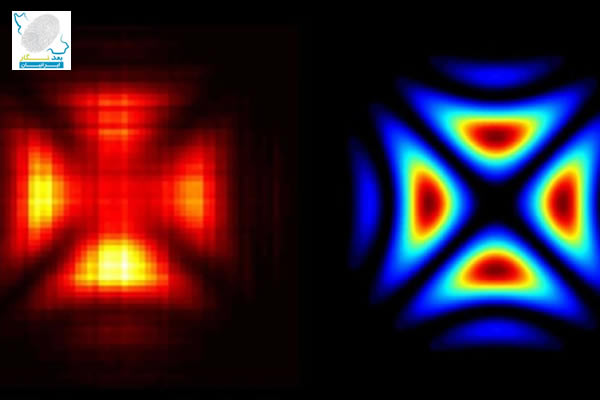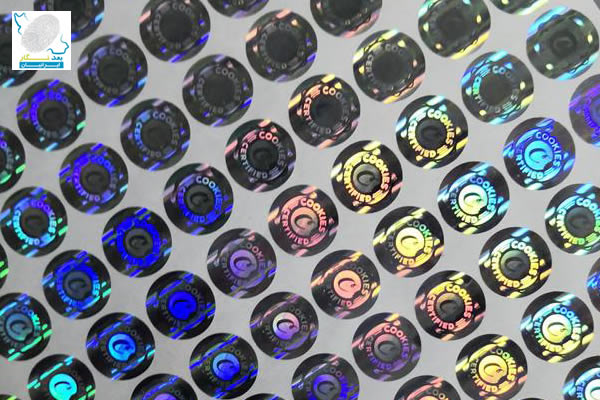Holography
Holography is a photographic technique that records the light scattered from an object, and then presents it in a way that appears three-dimensional. Holograms هولوگرام pop up in movies such as Star Wars and Iron Man, but the technology has not quite caught up to movie magic yet.
Various types of holograms have been made over the years, including transmission holograms, which allow light to be shined through them and the image to be viewed from the side; and rainbow holograms, which are used for security purposes on credit cards and driver s licenses, for example.

What is a hologram?
A hologram is a physical structure that diffracts light into an image. The term hologram هولوگرام can refer to both the encoded material and the resulting image.
A holographic image can be seen by looking into an illuminated holographic print or by shining a laser through a hologram and projecting the image onto a screen.
Other methods of projecting and reflecting images are often described as holographic or even misleadingly holograms, because they have an optical presence, spatial quality or iridescent colors.
While it the past it there was a clear distinction technology is evolving to create virtual holograms هولوگرام by steering light into an image. Augmented reality systems like the HoloLens often use a Holographic Optical Elements to make a video projection appear at comfortable viewing distance. The virtual objects in augmented reality are a kind of virtual hologram & not a hologram The Pepper s ghost technique, which uses a partially reflective surface to mix an image with the scene beyond. John Henry Pepper demonstrated the technique in the 1860s with it being used to overlay visual elements (often a figure ghost ) onto a physical set or stage.
When looking at the modulated structure under a microscope it does not look like the image encoded within. The density fringes are a distributed pattern of wavefront interference a frozen distributed recording of the direction, phase and amplitude of light (the visible spectrum of electron-magnetic radiation).
When the hologram is re-illuminated the light is diffracted through these fringes. If the direction and shape (curvature) of the light is the same as the reference beam then the hologram هولوگرام diffracts the light into the shape of the other wavefront, reconstructing the recorded image.
The relationships that can be set up with the holographic image suggest a particular way of considering optical information. While there are a number of ways of making holograms, each having their own aesthetic qualities they all have the same underlying principle. Holography is a way of encoding recording an interference pattern.
On encountering a hologram, what is most surprising is that a surface seems to hold a space. The difference of scale between the optical shaping by the hologram structure and our material sense of it as a surface produces a perception of a virtual form, as if the light holds its own shape.
Are Holograms For Real?
Holograms are as close as your wallet. Most driver s licenses include holograms, هولوگرام as well as ID cards and credit cards. Holograms can even be found throughout our houses. Holograms come as part of CD, DVD, Blu-Ray, and software packaging, as well as nearly everything sold as official merchandise .
But, these security holograms - which discourage forgery - aren t impressive. They simply change shape and color when tilted.
However, large-scale holograms, the kind illuminated with lasers or created in a dark room with carefully placed lighting, are phenomenal. They re basically two-dimensional surfaces that show very accurate three-dimensional images of real objects. You don t even have to wear special glasses like when you go to a 3D movie.
Holograms have surprising features. For example, each half contains whole views of the entire holographic image. The same is true if you cut out a small piece. Even a small fragment will still house the entire picture.
Understanding the principles behind holograms, هولوگرام helps you understand that the hologram, your brain, and light waves work together to make clear, 3D pictures.
by: Anna Kucirkova, IQS Directory
As technology continues to progress, we are given the opportunity to explore new and more exotic types of programming, software, hardware, and systems. One innovation that is growing at a rapid pace is hologram technology.
Holography is a photographic technique that records the light scattered from an object, and then presents it as three-dimensional.
Holograms of varying forms have appeared over the years, including transmission holograms, which allow light to be shined through them and the image to be viewed from the side, and rainbow holograms, هولوگرام like those used on credit cards and driver s licenses for increased security.
The development of hologram technology began in 1962, when Yuri Denisyuk, of the Soviet Union, and Emmett Leith and Juris Upatnieks, at the University of Michigan, developed innovative laser programs that recorded objects in 3D. They recorded on silver halide photographic emulsions at the time, but the clarity of the objects was far from perfect. New methods have improved holograms over time.
Are Holograms For Real?
Holograms are as close as your wallet. Most driver s licenses include holograms, as well as ID cards and credit cards. Holograms can even be found throughout our houses. Holograms come as part of CD, DVD, Blu-Ray, and software packaging, as well as nearly everything sold as official merchandise .

But, these security holograms - which discourage forgery - aren t impressive. They simply change shape and color when tilted.
However, large-scale holograms, هولوگرام the kind illuminated with lasers or created in a dark room with carefully placed lighting, are phenomenal. They re basically two-dimensional surfaces that show very accurate three-dimensional images of real objects. You don t even have to wear special glasses like when you go to a 3D movie.
Holograms have surprising features. For example, each half contains whole views of the entire holographic image. The same is true if you cut out a small piece. Even a small fragment will still house the entire picture.
Understanding the principles behind holograms, helps you understand that the hologram, your brain, and light waves work together to make clear, 3D pictures.
How Do Holograms Work?
To make a hologram, هولوگرام you record an object (or person) in a clean environment with a laser beam and apply the information to a recording medium that will clean up and clarify the image.
The laser beam is split in two and redirected with mirrors. One of the beams is directed at the object. A portion of the light reflects off the object and is recorded on the medium.
The second beam (reference beam), is directed toward the recording medium. This means the beams coordinate to make a precise image in the hologram location.
These two laser beams interfere and intersect with each other. The interference pattern is imprinted on the recording medium to recreate the 3D image.
What Are 3D Holograms?
3D holograms are coming into our lives. A 3D hologram هولوگرام is an object that isn t actually there, but looks like it is, either floating in mid-air or standing on a nearby surface. This augmented reality ( AR ) is a revolution well on its way.
Microsoft ( MSFT ) has its HoloLens headset, Apple ( AAPL ) uses ARKit, and Google ( GOOGL ) presents holograms in ARCore. The tech is saturating the tech market, and IT mega-corporations are racing to dominate the AR market.
3D hologram displays are the next step in more human-compatible digital content. The applications for the new technology are limitless.
A hologram projected in a room could show a 3D concept car like it was really there, and 3D presentations for meetings and conferences will wow audiences. And how about holographic telepresence? Yes, a hologram of you projected to a meeting room thousands of miles away!
Holograms have the potential to dramatically improve training, design, and visualization in many business settings and production facilities. Being able to look at, zoom in on and manipulate 3D versions of in-progress designs radically enhances the design process.
Even marketing departments can thrill customers with holograms هولوگرام through experiential marketing campaigns and 3D hologram interactions.
One product currently in development is called DeepFrame. This holographic tech enables science fiction-like applications, like 3D telepresence. The cost is prohibitive at $50,000, but as the use for experiential marketing and telepresence grows, competition will grow and costs will decrease.
There are also developers like Looking Glass Factory that are working on a display product called HoloPlayer that s currently available for $750 (PC dependent) or a $3,000 version (built-in PC).
A HoloPlayer displays 3D holograms on a sheet of glass, so you don t need special eyewear to view them. As Mike Elgan notes , the device creates …3D hologram هولوگرام objects that can be manipulated using in-air gestures. When you look straight on, you see the front of the image. Tilt your head to the side, and you see the side of the image. These can be manipulated with natural hand gestures - reaching out, pretending to grab and turning will rotate the 3D objects. In-the-air swiping gestures also work as expected, taking you to the next image in a series.
Holographic imagery is also coming soon to windshields everywhere. A current example, demonstrated at CES by a company called WayRay, is Navion.
This dashboard-mounted projector produces an overlay of navigation data and turn-by-turn directions on the road itself. Navion also identifies hazards, such as pedestrians, and highlights them on the windshield. Navion can be controlled with in-the-air hand gestures or voice commands.
What most technophiles are waiting for is 3D hologram هولوگرام displays for smartphones that project the hologram on or above the surface of the display. Samsung and LG have been developing this technology for several years, but they feel that 3D hologram support for smartphones is still decades away.
A rainbow hologram, recorded from a horizontal master strip and replayed with a light from above, will have horizontal parallax enabling the spatial qualities when looking with two eyes or moving side-to-side. But moving up-and-down produces no change in spatial perspective and viewer only sees a change of colour. By recording a number of masters on an achromatic angle the spectral colours can be recombine to produce images that are whitish (achromatic) or colour-mixed (ie, RGB red+green+blue).
Future of holography
For now, holograms are static. Recent presentations, such as CNN s special effect of a reporter appearing live from another location, and the late Tupac Shakur appearing live at a music festival, are not true holograms.
However, new holographic technology is being developed that projects 3D images from another location in real time. The images are also static, but they are refreshed every two seconds, creating a strobe-like effect of movement. The researchers hope to improve the technology over the next few years to bring higher resolution and faster image streaming.
And in March 2013, it was announced that a group of researchers from Hewlett Packard Laboratories has developed glasses-free, multi-perspective, 3D display technology for mobile devices

How holography works
To create a hologram, هولوگرام you need an object (or person) that you want to record; a laser beam to be shined upon the object and the recording medium; a recording medium with the proper materials needed to help clarify the image; and a clear environment to enable the light beams to intersect.
A laser beam is split into two identical beams and redirected by the use of mirrors. One of the split beams, the illumination beam or object beam, is directed at the object. Some of the light is reflected off the object onto the recording medium


